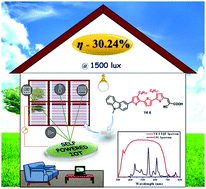Indoor light-harvesting dye-sensitized solar cells surpassing 30% efficiency without co-sensitizers†
Abstract
Dye-sensitized solar cells (DSCs) have proven to be one of the best photovoltaic approaches for harnessing indoor/artificial light. Herein, we report two new molecularly engineered, cost-effective, metal-free, carbazole-based D–π–A sensitizers (YK 8 and YK 9) by judiciously varying their π-spacers, which are suitable for indoor photovoltaic applications. Using YK 8, we achieved an efficiency of 28.7% under standard 1000 lux Osram 14 W T2 cool day light fluorescent tube illumination with a power output of 68.88 μW cm−2 and 30.24% with a power output of 108.85 μW cm−2 under a higher illumination intensity of 1500 lux without co-sensitizers using iodide/triiodide electrolyte. With a small footprint/active area of 1.24 cm2, we could power a temperature sensor completely autonomously at a low light intensity of 500 lux, displaying the potential of these indoor photovoltaic devices to serve as energy sources for low-power sensors and actuators on the Internet of Things (IoT) network, reducing the dependence on batteries and leading to a smaller carbon footprint. The role of the π-spacer and its influence on recombination and device performance were explored via extensive interfacial studies.



 Please wait while we load your content...
Please wait while we load your content...